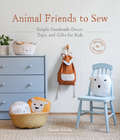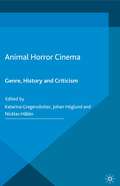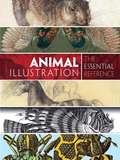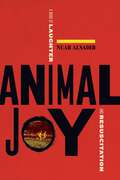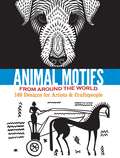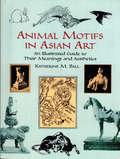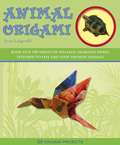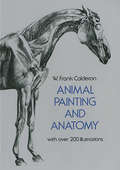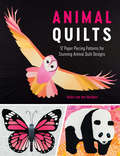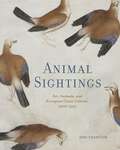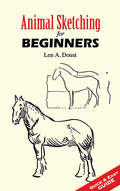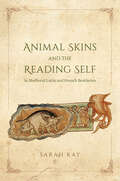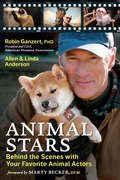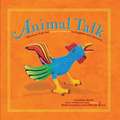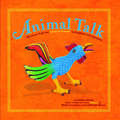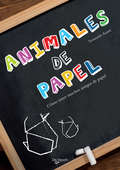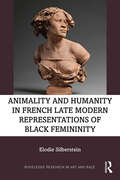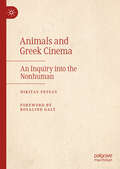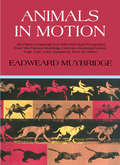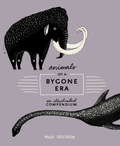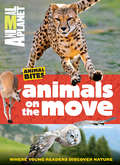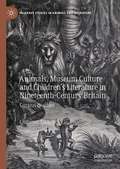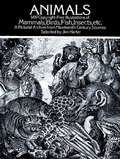- Table View
- List View
Animal Friends to Sew: Simple Handmade Decor, Toys, and Gifts for Kids
by Sanae IshidaSew adorable animal-themed projects for kids' room decor, handmade toys, and wearable accessories.Create beautiful handmade animal friends for the whole family: a darling whale teether, adorable fox baby slippers, stackable animal blocks, a sweet lion throw pillow, or a fuzzy sheep backpack! Perfect for gifting, these one-of-a-kind handmade treasures are sure to be cherished. Inspired by the beautiful simplicity of Japanese and Scandinavian design, these projects will delight the creator as much as the recipient. 15 beginner-friendly projects with 35+ variations. Includes lookbook at the front followed by a sewing and embroidery primer, project instructions with photos and step-by-step illustrations, and templates at the back.
Animal Horror Cinema: Genre, History and Criticism
by Johan Höglund Katarina Gregersdotter Nicklas HållénThis first full-length scholarly study about animal horror cinema defines the popular subgenre and describes its origin and history in the West. The chapters explore a variety of animal horror films from a number of different perspectives. This is an indispensable study for students and scholars of cinema, horror and animal studies.
Animal Illustration: The Essential Reference
by Carol Belanger GraftonComprehensive and entertaining, this volume comprises the greatest works in animal illustration from the Middle Ages through the twentieth century. The chronological presentation of hundreds of black-and-white and color images begins with a medieval illuminated manuscript by the Limbourg brothers and the Renaissance works of Albrecht Dürer and other artists from the first centuries of printing. Subsequent illustrations include the seventeenth-century real and imaginary animals of Matthäus Merian and the unique eighteenth-century compilations of Albertus Seba. Nineteenth-century images are drawn from sources as diverse as J. G. Heck's Bilder Atlas; the prints of Georges Baron Cuvier; William Jardine's 40-volume Naturalist's Library; bird illustrations by John James Audubon, Alexander Wilson, Edward Lear, and many others; extraordinary butterfly and insect images by E. A. Seguy, as well as animal illustrations from Victorian chromolithograph die cuts. The exquisite Edwardian bestiary of the Detmold brothers brings the collection into the twentieth century, and ends with the imagery of contemporary dinosaur artist James Gurney.Detailed bibliographical information concerning every source—including biographical details of each artist—makes this collection a vital reference tool as well as a splendid resource of outstanding animal illustrations. Students of graphic art and illustration, as well as graphic designers and advertising professionals, will prize this treasury of material from many rare historic sources.
Animal Joy: A Book of Laughter and Resuscitation
by Nuar AlsadirA Time Must-Read Book of 2022 A Publishers Weekly Best Book of 2022Aster(ix) Journal's 12 Best Nonfiction Books of 2022An invigorating, continuously surprising book about the serious nature of laughter.Laughter shakes us out of our deadness. An outburst of spontaneous laughter is an eruption from the unconscious that, like political resistance, poetry, or self-revelation, expresses a provocative, impish drive to burst free from external constraints. Taking laughter’s revelatory capacity as a starting point, and rooted in Nuar Alsadir’s experience as a poet and psychoanalyst, Animal Joy seeks to recover the sensation of being present and embodied. Writing in a poetic, associative style, blending the personal with the theoretical, Alsadir ranges from her experience in clown school, Anna Karenina’s morphine addiction, Freud’s un-Freudian behaviors, marriage brokers and war brokers, to “Not Jokes,” Abu Ghraib, Frantz’s negrophobia, smut, the Brett Kavanaugh hearings, laugh tracks, the problem with adjectives, and how poetry can wake us up. At the center of the book, however, is the author’s relationship with her daughters, who erupt into the text like sudden, unexpected laughter. These interventions—frank, tender, and always a challenge to the writer and her thinking—are like tiny revolutions, pointedly showing the dangers of being severed from one’s true self and hinting at ways one might be called back to it.A bold and insatiably curious prose debut, Animal Joy is an ode to spontaneity and feeling alive.
Animal Motifs from Around the World: 140 Designs for Artists & Craftspeople
by Doris RosenthalDrawn from the ancient art and artifacts of an international array of museum collections, this spectacular volume offers a unique selection of unusual animal motifs from Prussia, Egypt, Persia, China, Germany, Sweden, and other areas. The edgy designs possess a timeless appeal that makes them especially attractive to contemporary designers, tattoo artists, crafters, and others.
Animal Motifs in Asian Art: An Illustrated Guide to Their Meanings and Aesthetics
by Katherine M. BallAuthoritative reference deals primarily with animal symbolism in Japanese art, with occasional mention of the decorative art of China, India, and Persia. Arranged in the format of a dictionary, the explanatory text is rich with sidelights from literature and legend, while 673 black-and-white illustrations depict dragons, tigers, bats, and other creatures with symbolic significance.
Animal Origami: 20 Origami Projects (Origami Books)
by Joost LangeveldBring your favorite animals to life with nothing more than a piece of paper! Animal Origami uses the art of folding to bring you into the wild world of the animal kingdom.Animal Origami offers animal lovers a chance to experience animals in an entirely new way—by creating them! This fun and informative book offers instructions for crafting crabs, cows, dinosaurs, ladybugs, and more.Animals can be intriguing, fun, and fascinating—and with Animal Origami, making them can be all those things too!
Animal Painting and Anatomy
by W. Frank CalderonDrawing is "the very essence of all pictorial art," and this book approaches the challenging art of animal painting from the point of view of accurate representation of animal subjects on canvas. Combining useful information on important anatomical features with direction on how to handle the subjects and how to express their forms and postures, the author has produced a complete, inexpensive, at-home course in animal painting and anatomy.All aspects of animal drawing and painting are covered: drawing from life; anatomy in relation to drawing (not surgical anatomy, but a precise knowledge of the visible structure and movements of animals); characteristic movements of animals and suggestions on how to capture them in your picture; composition (design, restraint, rhythm, balance of light and shade, relative scale of animals and landscape, foregrounds); painting and color. 36 illustrations, mostly sketches by the author, depict horses, pigs, cows, dogs, and other animals in various life positions and movements. A long, detailed discussion of the anatomy of animals completes the book. Here Mr. Calderon describes all the structures of animals that are of significance to the artist: the vertebral skeleton, the bones and muscles of the head, the muscles of the vertebral skeleton, the fore-limb and its muscles, the muscles attaching the shoulder blade to the trunk, and the bones and muscles of the hind limb. 208 drawings accompany these discussions and show you how anatomy is related to surface contours and techniques of shading.
Animal Quilts: 12 Paper Piecing Patterns for Stunning Animal Quilt Designs
by Juliet van der HeijdenCreate incredible quilts for your home with this collection of foundation paper-pieced quilt patterns featuring 12 different animals. Learn how to create realistic representations of your favourite animals and birds in stunning paper-pieced quilt blocks. This unique collection of 12 contemporary quilt patterns includes a tiger, butterfly, swan, owl, peaccok and polar bear as well as many more. There are instructions to show how to resize the quilt blocks if you want to make them larger, as well as instructions for how to add borders to increase the size of the overall quilt. Juliet also explains how the fabric choice can really alter the overall effect of the quilt patterns to create very different results, and she encourages you to have fun and adapt the quilt patterns through your own choice of fabrics. There are step-by-step instructions showing Juliet's foundation paper-piecing techniques and a handy CD with all the pattern pieces ready to print out.
Animal Sightings: Art, Animals, and European Court Culture, 1400–1550
by Jodi CranstonAnimal Sightings challenges two common ideas about the depiction of animals in early modern European court art: first, that the human figure relegated animals to peripheral and often symbolic roles, both compositionally and conceptually, and second, that the representation of animals during this period was predominantly tied to a growing interest in naturalism derived from scientific study and discovery. Art historian Jodi Cranston considers the diversity of art representing animals common to that time and place, including dogs, stags, falcons, and even insects. She discusses how early modern European courts (primarily in northern Italy, Tyrol, Saxony, and southern Germany, where the preponderance of European courtly activity related to animals occurred) acquired and kept living animals, sponsored hunts in purpose-cultivated forests, and fostered trade in animal products. The diverse works created by artists associated with those courts reveal an ambivalent and complex view of animals as beings who shared and shaped the world alongside humans. Ultimately, Animal Sightings explores how early modern artists and viewers thought about human-animal interactions, how visual representation facilitated and inhibited knowledge about animals, and how animals could reveal the limits and possibilities of visual representation. It should be of special interest to scholars of early modern studies, art history, and animal studies.
Animal Sketching for Beginners
by Len A. DoustThis handy manual provides the confidence, insight, and guidance to help any sketcher create realistic animal drawings. With the help of the author's thirty-one clearly detailed drawings, this basic how-to-guide:* illustrates major attributes shared by many animals* shows how simple shapes can create complex drawings* functions as a valuable anatomy referenceA source of inspiration for artists at all levels, this book will be especially helpful to beginning art students.
Animal Skins and the Reading Self in Medieval Latin and French Bestiaries
by Sarah KayJust like we do today, people in medieval times struggled with the concept of human exceptionalism and the significance of other creatures. Nowhere is this more apparent than in the medieval bestiary. Sarah Kay’s exploration of French and Latin bestiaries offers fresh insight into how this prominent genre challenged the boundary between its human readers and other animals. Bestiaries present accounts of animals whose fantastic behaviors should be imitated or avoided, depending on the given trait. In a highly original argument, Kay suggests that the association of beasts with books is here both literal and material, as nearly all surviving bestiaries are copied on parchment made of animal skin, which also resembles human skin. Using a rich array of examples, she shows how the content and materiality of bestiaries are linked due to the continual references in the texts to the skins of other animals, as well as the ways in which the pages themselves repeatedly—and at times, it would seem, deliberately—intervene in the reading process. A vital contribution to animal studies and medieval manuscript studies, this book sheds new light on the European bestiary and its profound power to shape readers’ own identities.
Animal Stars
by Allen Anderson Robin GanzertWhen cameras roll and directors call, "Action," some of the most dependable, funniest, and most enthusiastic actors stand poised on four legs, with ears alert. From Joey in War Horse to the wolves in Game of Thrones, what we see on screen is the result of meticulous preparation and professional teamwork. The eye-popping, heartwarming stories in these pages reveal the trainers, actors, directors, and, of course, dogs, cats, horses, penguins, deer, and other animals in all their behind-the-scenes glory. You'll discover that some animal actors have diva tendencies and others have rags-to-riches backstories. American Humane Association certified animal safety representatives work carefully to ensure that no animals are harmed, as they have been doing for decades. Animal stars have done it all -- convinced us to eat more tacos, broken our hearts in war dramas, inspired us with enduring love and loyalty, kept us at the edge of our seats as they snarled in the shadows, mirrored human antics to make us roar with laughter, and, like Uggie (from The Artist), stolen the show on the red carpet. Who besides a monkey named Crystal could impress a brilliant comedian like Robin Williams in Night at the Museum? And animal stars will work for food, including only KFC original recipe for Casey the bear -- no other fried chicken will do! These charming and sometimes hilarious stories will give you a new appreciation for the skill and patience it takes to teach nonhuman actors to perform on camera. Training tips from the pros and personal recollections of celebrities such as Julia Roberts, Hailee Steinfeld, and Steven Spielberg make this insider's look at the lives and work of these incomparable stars as irresistible as the animals themselves. A portion of the publisher's proceeds from this book will aid American Humane Association.
Animal Talk: Mexican Folk Art Animal Sounds in English and Spanish (First Concepts in Mexican Folk Art)
by Cynthia WeillDid you know that animals that live in one country don't always talk the same language as animals from somewhere else? Take a rooster, for instance. In English-speaking countries, he says cock-a-doodle-doo when he has a notion to announce himself or to greet the dawn. But in Spanish-speaking countries, he says ki-kiri-ki. Emerging readers will delight in identifying the animals depicted on each new page. And the bilingual text invites parent and child into an interactive and playful reading experience for acting out animal sounds in English and Spanish. <p>Craftsman Rubí Fuentes and Efraín Broa from the Mexican state of Oaxaca fill the pages of Animal Talk with vibrant, wildly imaginative figures of familiar animals. Animal Talk is the fifth book in Cynthia Weill's charming First Concepts in Mexican Folk Art series. It is her passion to promote the work of artisans from around the world through early concept books.
Animal Talk: Mexican Folk Art Animal Sounds in English and Spanish (First Concepts in Mexican Folk Art)
by Cynthia WeillFrom Oaxaca, Mexico, come vibrant wood carvings of animals that invite children to learn animal sounds in English and Spanish. Desde Oaxaca, México, vienen vibrantes tallados en madera de animales que invitan a los niños a aprender los sonidos de los animales en inglés y español.Did you know that animal noises can sound different in different languages? A goat greets you with "meh, meh" in English and "bee bee" in Spanish. And in English a rooster calls out "cock-a-doodle-doo" to greet the dawn, while a rooster loudly crows "ki-kiri-ki" in Spanish. Young readers will delight in identifying the fifteen imaginative figures of familiar animals in this charming bilingual book, while the text invites children to imitate animal sounds in English and Spanish. This is the perfect book for an interactive and playful beginning reading experience. ¿Sabías que los ruidos de los animales pueden sonar diferentes en diferentes idiomas? Una cabra te saluda con "meh, meh" en inglés y "bee bee" en español. Y en inglés, un gallo grita "cock-a-doodle-doo" para saludar al amanecer, mientras que un gallo canta en voz alta "ki-kiri-ki" en español. Los lectores jóvenes se deleitarán al identificar las quince imaginativas figuras de animales familiares en este encantador libro bilingüe, mientras que el texto invita a los niños a imitar los sonidos de los animales en inglés y español. Este es el libro perfecto para una experiencia de lectura inicial interactiva y lúdica.
Animales de papel
by Emanuele AzzitàUna hoja de papel cualquiera en tus manos y el libro abierto; lee las instrucciones, mira los dibujos y dobla el papel, despacito y con cuidado... verás que, como por arte de magia, ¡la hoja de papel ha desaparecido y tienes ante ti un cisne! (o una rana o el animal que hayas elegido). Así de fácil y de divertida es la papiroflexia. Si practicas con frecuencia, lo harás cada vez mejor y, si además utilizas papeles de colores distintos o pintas tus obras con lápices de colores, pronto podrás tener los animales de tu propio zoo, de tu granja o de tu selva. La papiroflexia es una actividad muy fácil de practicar que, sin más gastos, procura grandes momentos de diversión, y que el padre y la madre podrán compartir con sus hijos e hijas. Ayuda a desarrollar la habilidad manual, la imaginación y la creatividad; mejora la autoestima de los niños y niñas que comprueban que son capaces de crear sus propios juguetes. Usted puede también enseñarles a reciclar el papel usado para sus juegos a la vez que los aleja de la televisión y otras pantallas electrónicas. Emanuele Azzità es un gran experto en papiroflexia que ha publicado varias obras sobre este tema en Editorial De Vecchi. En esta ocasión, se ha propuesto presentar graciosos proyectos, apropiados para los más jóvenes de la casa.
Animality and Humanity in French Late Modern Representations of Black Femininity (Routledge Research in Art and Race)
by Elodie SilbersteinThis volume examines the evolution of the depictions of black femininity in French visual culture as a prism through which to understand the Global North’s destructive relationship with the natural world. Drawing on a broad spectrum of archives extending back to the late 18th century – paintings, fashion plates, prints, photographs, and films – this study traces the intricate ways a patriarchal imperialism and a global capitalism have paired black women with the realm of nature to justify the exploitation both of people and of ecosystems. These dehumanizing and speciesist strategies of subjugation have perpetuated interlocking patterns of social injustice and environmental depletion that constitute the most salient challenges facing humankind today. Through a novel approach that merges visual studies, critical race theory, and animal studies, this interdisciplinary investigation historicizes the evolution of the boundaries between human and non-human animals during the modern period. The book will be of interest to scholars working in art history, visual studies, critical race theory, colonial and post-colonial studies, animal studies, and French studies.
Animals and Greek Cinema: An Inquiry into the Nonhuman
by Nikitas FessasThis book offers a non-anthropocentric account of a national cinema. Drawing on cutting-edge developments in Animal (film) studies, the book gathers a wide range of species and genres to discuss the Greek cinematic animal. This en-tails recalibrating the readers&’/viewers&’ gazes to include particular nonhumans, often displaced in the frame&’s margins. While acknowledging the cost paid in animal suffering for Greek cinema to rise, the book features instances of animal-human bonding. Combining close readings with interviews with directors, human actors, screenwriters, cinematographers, producers, special effects artists, and animal wranglers, this book proposes a paradigm of human-animal praxis, arguing that revisiting nonhuman images can lead to renewed ethical relations, and to less speciesist cinemas, film industries, and societies.
Animals in Art
by Jessica RawsonAnimals have been the subject of art from the time that man started to draw, engrave and carve. They have been and are almost as important to men as man himself. In many societies and at many periods animals have been the most prominent subject of art. But this art shows much more varied attitudes to animals than those we today at first expect. In modern urbanised society we look on most animals from a distance. This distance is not bridged by the great extent of our modern scientific knowledge.
Animals in Motion
by Eadweard Muybridge"The dry plate's most spectacular early use was by Eadweard Muybridge." -- Life"A really marvelous series of plates." -- Nature (London)"These photographs have resolved many complicated questions." -- Art JournalHere is the largest, most comprehensive selection of Muybridge's famous animal photos -- more than 4,000 high-speed shots of 34 different animals and birds, in 123 different types of actions. Animals are shown walking, running, leaping, flying -- in typical actions. The horse alone is shown in more than 40 different ways: galloping with nude rider, trotting, pacing with sulky, cantering, jumping hurdles, carrying, rolling on barrels, and 36 other actions. All photos taken against ruled backgrounds; most actions taken from 3 angles at once: 90 degrees, 60 degrees, rear. Foreshortened views are included. These are true action photos, stopped in series, taken at speeds up to 1/2000th of a second. Actions are illustrated in series, with as many as 50 shots per action. Muybridge worked with the University of Pennsylvania for three years, made more than 100,000 exposures, and spent more than $50,000. His work has never been superseded as a lifetime reference for animators, illustrators, artists, and art directors.
Animals of a Bygone Era: An Illustrated Compendium
by Maja SäfströmA beautifully illustrated collection of fascinating, surprising, and funny facts about extinct animals.In the past, amazing and strange animals roamed the earth, including giant sea scorpions, tiny horses, enormous sloths, and fierce "terror birds." These and many more fantastic extinct animals are illustrated in this whimsical collection by Swedish artist Maja Säfström.
Animals on the Move (Animal Bites Ser.)
by Dorothea Di PriscoWith more than 200 gorgeous photos of animals in their natural habitats, there's action and adventure on every page of Animals on the Move. This fast-moving addition to the Animal Bites series provides kids in the first years of schooling with the perfect bite-sized view of their favorite animals. Arranged thematically with a focus on animal behavior and family relationships, young readers will explore sections about migration, fast and slow, hunting and playing, and animal movement on land, in the air, and in water, Special book features designed for this age group include simple graphics and 'Just Like Me' sidebars with fascinating animal facts for young readers to learn more about themselves and the amazing animals that share our world.
Animals, Museum Culture and Children’s Literature in Nineteenth-Century Britain: Curious Beasties (Palgrave Studies in Animals and Literature)
by Laurence TalairachAnimals, Museum Culture and Children’s Literature in Nineteenth-Century Britain: Curious Beasties explores the relationship between the zoological and palaeontological specimens brought back from around the world in the long nineteenth century—be they alive, stuffed or fossilised—and the development of children’s literature at this time. Children’s literature emerged as dizzying numbers of new species flooded into Britain with scientific expeditions, from giraffes and hippopotami to kangaroos, wombats, platypuses or sloths. As the book argues, late Georgian, Victorian and Edwardian children’s writers took part in the urge for mass education and presented the world and its curious creatures to children, often borrowing from their museum culture and its objects to map out that world. This original exploration illuminates how children’s literature dealt with the new ordering of the world, offering a unique viewpoint on the construction of science in the long nineteenth century.
Animals, Plants, and Landscapes: An Ecology of Turkish Literature and Film (Perspectives on the Non-Human in Literature and Culture)
by Hande Gurses Irmak Ertuna HowisonThe landscape of Turkey, with its trees and animals inspires narratives of survival, struggle and escape. Animals, Plants, and Landscapes: An Ecology of Turkish Literature and Film, will be the first major study to offer fresh theoretical insight into this landscape, by offering a collection of analyses of key texts of Turkish literature and cinema. Through discussion of both classical and contemporary works, this volume, paves the way for the formation of a ecocritical canon in Turkish literature and the rise of certain themes that are unique to Turkish experience. Snakes, fishermen and fish who catch men, porcupines contemplating on human agency, dogs exiled on an island and men who put dogs to fights, goat herders and windy steppes of Anatolia are all agents in a territory that constantly shifts. The essays included in this volume demonstrate the ways in which the crystallized relations between human and non-human form, break, and transform.
Animals: 1,419 Copyright-Free Illustrations of Mammals, Birds, Fish, Insects, etc (Dover Pictorial Archive)
by Jim HarterSelected for its visual impact and ease of use, this outstanding collection of wood engravings presents over 1,000 species of animals in extremely lifelike poses. Includes many different versions of familiar mammals, birds, reptiles, amphibians, fish, insects, and other invertebrates such as spiders, crabs, squid, earthworms, and more. Captions provide modern common-name identifications.
